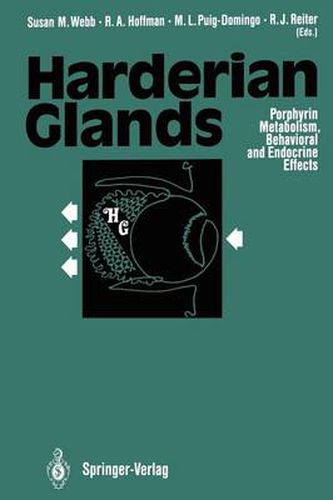Readings Newsletter
Become a Readings Member to make your shopping experience even easier.
Sign in or sign up for free!
You’re not far away from qualifying for FREE standard shipping within Australia
You’ve qualified for FREE standard shipping within Australia
The cart is loading…






This title is printed to order. This book may have been self-published. If so, we cannot guarantee the quality of the content. In the main most books will have gone through the editing process however some may not. We therefore suggest that you be aware of this before ordering this book. If in doubt check either the author or publisher’s details as we are unable to accept any returns unless they are faulty. Please contact us if you have any questions.
Harderian glands, first described by Jacob Harder in two species of deer in 1694, are large, intraorbital glands which, with but few exceptions, are found in all land vertebrates. Certainly, their relatively large size, their phylogenetic age, and persistent conservation in all groups as they emerged from an aqueous to an air/land environment lend strong support to the logical deduction that they probably play an important role in the physiological adaptation to terrestrial life. Yet, few biologists know even what or where these glands are. For a variety of reasons, the Harderian glands have not received the attention they deserve and, as a result, the published works available have been scarce and scattered throughout the world literature. The current situation is remarkably similar to that which existed in regard to the pineal gland prior to the mid-1960s, i. e. , scattered literature, unknown function, few investigators, and little interest. Yet, following a few key papers, interest in the pineal gland expanded and soon an explosive increase in the knowledge and understanding of the pineal gland took place and continues today. Will history repeat itself? Originally, a few of us discussed the desirability of an informal Symposium on the Harderian glands.
$9.00 standard shipping within Australia
FREE standard shipping within Australia for orders over $100.00
Express & International shipping calculated at checkout
This title is printed to order. This book may have been self-published. If so, we cannot guarantee the quality of the content. In the main most books will have gone through the editing process however some may not. We therefore suggest that you be aware of this before ordering this book. If in doubt check either the author or publisher’s details as we are unable to accept any returns unless they are faulty. Please contact us if you have any questions.
Harderian glands, first described by Jacob Harder in two species of deer in 1694, are large, intraorbital glands which, with but few exceptions, are found in all land vertebrates. Certainly, their relatively large size, their phylogenetic age, and persistent conservation in all groups as they emerged from an aqueous to an air/land environment lend strong support to the logical deduction that they probably play an important role in the physiological adaptation to terrestrial life. Yet, few biologists know even what or where these glands are. For a variety of reasons, the Harderian glands have not received the attention they deserve and, as a result, the published works available have been scarce and scattered throughout the world literature. The current situation is remarkably similar to that which existed in regard to the pineal gland prior to the mid-1960s, i. e. , scattered literature, unknown function, few investigators, and little interest. Yet, following a few key papers, interest in the pineal gland expanded and soon an explosive increase in the knowledge and understanding of the pineal gland took place and continues today. Will history repeat itself? Originally, a few of us discussed the desirability of an informal Symposium on the Harderian glands.